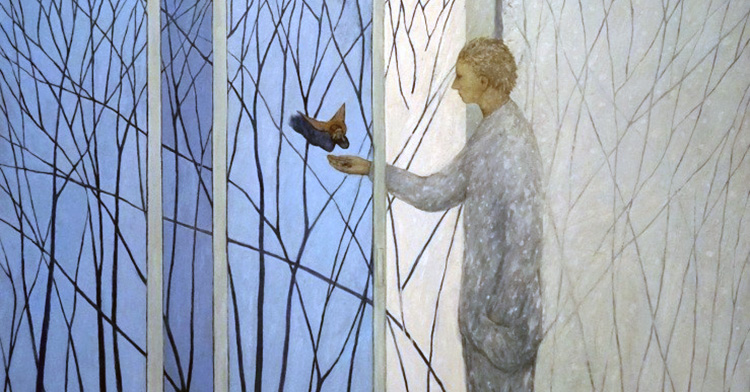Imagine that at the end of a stressful, harried day, you go for a short walk around the neighborhood. Halfway through, a robin flies low enough to catch your eye. You look up. Your eyes land on a maple tree. The limbs, heavy with leaves, shiver in the wind.
And just as the wind lifts the leaves, the sight of the living, supple tree laden with greenness lifts you. Beauty has provided a moment of respite from the heaviness of life, the heaviness of the tired mind.
Another example: In the cramped room where a teacher grades papers or an accountant pores over ministry budgets yet again, he or she has hung a still life by Paul Cézanne. The apples in the still life blaze with color; the jug radiates its jade-green hues. The colors, in their boldness, their inherent reference to life and vibrancy, bless the person in the room with affirming presence.
Or maybe what’s on the wall isn’t a painting; it’s a photograph of beloved faces, shining out from the frame with familiar, enduring beauty that stirs the heart with warmth and graciousness.
There’s no doubt that beauty brings relief, warmth and graciousness. So if asked, “Does beauty matter?” most of us would probably give a resounding yes.
I think, then, it is worth asking, “Does beauty matter for our moral stances?” By moral stance, I mean the particular positions we take regarding the problems and issues surrounding us and the cultures we are part of, positions informed by our moral vision of what is right and wrong.
What does beauty, we may ask, have to do with this?
Imagine something else. Imagine walking on a cold evening to a known destination. Black clouds loom over the horizon line, darkening by the moment. You scan the shadowed hills. Suddenly, out shines a small, bright patch of yellow.
Someone has lit a lantern. That light from a small, bright flame makes an abiding difference to the walk. It doesn’t necessarily show the way (there might be a stream or a ditch between you and the light), but it gives presence; it welcomes and greets you.
In her gem of a book “On Beauty and Being Just,” Elaine Scarry writes that beauty is welcoming: “Not Homer alone but Plato, Aquinas, Plotinus, Pseudo-Dionysius, Dante, and many others repeatedly describe beauty as a ‘greeting.’ At the moment one comes into the presence of something beautiful, it greets you. … In its etymology, ‘welcome’ means that one comes with the well-wishes or consent of the person or thing already standing on that ground.”
What would it mean if our moral stances shared something with this welcoming force? This well-wishing, this givingness, of beauty could help a moral stance to be more becoming (a particularly felicitous word here) -- more apt to garner both interest and realization.
Like love, beauty gives and does not stint. A tree cannot hide its limbs, nor a concerto by Rachmaninoff refuse to move along its chords. Beauty isn’t just ornamentation or sentimentality; it provides the life-giving force of warm, appealing graciousness to what could otherwise be moralistic positions in danger of never blooming into real-time goodness.
How can we cultivate something as important as our responses to the needs and problems of the world so that they may offer some fair light, even just a pinprick, against the darkness through which we are all trying to walk?
Beyond an abstract argument, I’d like to offer three ideas of how to foster a formative relationship between the force of beauty and our moral positions.
Learn from the rich tradition of craftsmanship. If we are trying to make something beautiful and welcoming -- a broad, strong dinner table, for instance -- it takes time and work. This time and work speaks to a posture of learning, of humility.
Writing about Simone Weil’s philosophy on beauty, Scarry notes that in the encounter with something beautiful (lantern light, table, face), we are radically decentered: “It is not that we cease to stand at the center of the world, for we never stood there. It is that we cease to stand even at the center of our own world.”
A moral stance can learn something of this humble craftsmanship, in that the more it is hewn with care -- from long conversations, wise thought, purposeful interactions -- the more it stands a chance to realize goodness in the world.
Read novels. Reading the strong contours of fictional characters within moving drama hones our ability to ascertain the ugliness of human traits -- say, of brittleness or unevenness or stinginess -- a process that, hopefully, gives us insight to what may be inadequate in our own moral stances.
One of my favorite examples of this is the stepmother in Elizabeth Gaskell’s “Wives and Daughters.” The character Hyacinth is in no way evil -- she’s at times dearly sympathetic -- but she is, in the guise of prudence, stingy. She’s stingy with love, protection and desserts.
Reading her character inevitably shines a rather discomforting light on my own habits of using “niceness” or “goodness” to self-protect my little fiefdom.
Create the beauty of small, real kindnesses. Bring over cookies; offer to watch the kids; take time for walking and talking; lend a book; give away a favorite record. This is extending a tangible form of action that -- through graciousness and welcome -- allows a potentially unlit or dim moral stance the satisfaction of becoming a warm, living instance of goodness.
In this way, even if and when our inner moral systems are under duress, we are still, as night falls, lighting a lantern for others.













